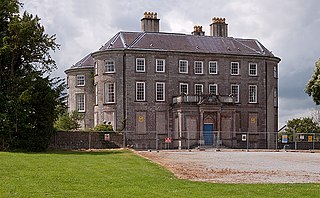
Buttevant is a medieval market town in County Cork, Ireland.

Doneraile, historically Dunnerail, is a town in County Cork, Ireland. It is on the R581 regional road 8 km (5.0 mi) east of the N20 road, which runs from Limerick to Cork. It is about 12 km (7.5 mi) north of Mallow town. It is on the River Awbeg, a branch of the Blackwater. The town is in a townland and civil parish of the same name. Doneraile is part of the Cork East Dáil constituency.

Ahascragh is a village in east County Galway, Ireland. It is located 11 km (7 mi) north-west of Ballinasloe on the Ahascragh/Bunowen River, a tributary of the River Suck. The R358 regional road passes through the village. As of the 2022 census, it had a population of 186 people. The village is in a civil parish of the same name.
Roxborough is a townland in County Limerick, Ireland comprising some 24.02 km2. It lies to the south of the townlands of Ballysheedy and Routagh and to the east of the townland of Ballyclough. Its northern boundary, partially bounded by the Ballyclough River, lies some three kilometres to the south of the Limerick City boundary at Southill. The Limerick to Fedamore road (R511) bounds the west side of Roxborough.

Kilworth is a village in north County Cork, located about 2 km (1.2 mi) north of Fermoy near the River Funshion. The M8 Cork–Dublin motorway passes nearby. Kilworth has an army camp, located on the R639 regional road between Mitchelstown and Fermoy. The village is in a townland and civil parish of the same name. Kilworth is part of the Cork East Dáil constituency.

Glenville is a village and townland in County Cork, Ireland. It is situated approximately 20 km northeast of Cork city. Glenville is part of the Cork North-Central.

Ballyclogh or Ballyclough is a small village 8 km (5 mi) outside Mallow, County Cork, Ireland. The name Ballyclogh has its origins in the past abundance of stone quarries in the area. The village is in a townland and civil parish of the same name. Ballyclogh is part of the Cork East Dáil constituency.
The High Sheriff of County Cork was the Sovereign's judicial representative in County Cork. Initially an office for lifetime, assigned by the Sovereign, the High Sheriff became an annual appointment following the Provisions of Oxford in 1258. Besides his judicial importance, the sheriff had ceremonial and administrative functions and executed High Court Writs.
Fermoy is a historical barony in County Cork in Ireland. It is bordered by the baronies of Orrery and Kilmore to the north-west; Duhallow to the west; Barretts to the south-west; Barrymore to the south; Condons and Clangibbon to the east; and Coshlea, County Limerick to the north. It is bounded to the south by the Nagle Mountains and the valley of the Munster Blackwater. The Ballyhoura Mountains mark the northern boundary. A tributary of the Blackwater, the Awbeg has two branches in its upper stretches; one branch forms the northern boundary while the other near Buttevant, forms the western limit. To the east, lies another Blackwater tributary, the Funcheon. Anomalously, the namesake town of Fermoy is actually in the barony of Condons and Clangibbon. The town with the greatest population in the barony is Mallow.

Castle Harrison, formerly Castle Dodd, was a great house close to Ballyhea and Charleville, in north County Cork, Ireland. The seat of the Harrison family for some time, the house was demolished in the 1950s.

St Leger St Leger, 1st Viscount Doneraile, 2nd creation was an Anglo-Irish politician and peer, who was a member of Parliament for Doneraile from 1749 to 1776. He is known for his conviction for assaulting a Catholic priest, and for challenging the prosecuting counsel, John Philpot Curran, to a duel.

Bowen's Court was a historic country house or Anglo-Irish big house near Kildorrery in County Cork, Ireland.

Bartholomew Purdon was a County Cork landowner and a long-serving member of the Irish House of Commons. He was also a Justice of the Peace and served as Deputy Lord Lieutenant of County Cork for many years. He was High Sheriff of County Cork in 1708–9.

Castlefreke, also known as Rathbarry, is a townland and village in County Cork, Ireland. The townland is located in the civil parish of Rathbarry on the R598 regional road, to the east of Rosscarbery.
Jamesbrook is a townland in the civil parish of Garranekinnefeake, in the historical Barony of Imokilly, in County Cork, Ireland. As of the 2011 census, the townland of Jamesbrook had a population of 39 people.

Castlehyde is a townland and estate, slightly west of Fermoy in County Cork, Ireland. The estate's manor house, Castlehyde House, had been the ancestral home of Douglas Hyde's family and is one of several houses owned by Irish dancer, Michael Flatley.

Kinalea is a historical barony in central County Cork, Ireland.

Kinnatalloon is a historical barony in east County Cork, Ireland.

Orrery and Kilmore is a historical barony in north County Cork, Ireland.

Kinsale is a historical barony in south County Cork, Ireland.


















